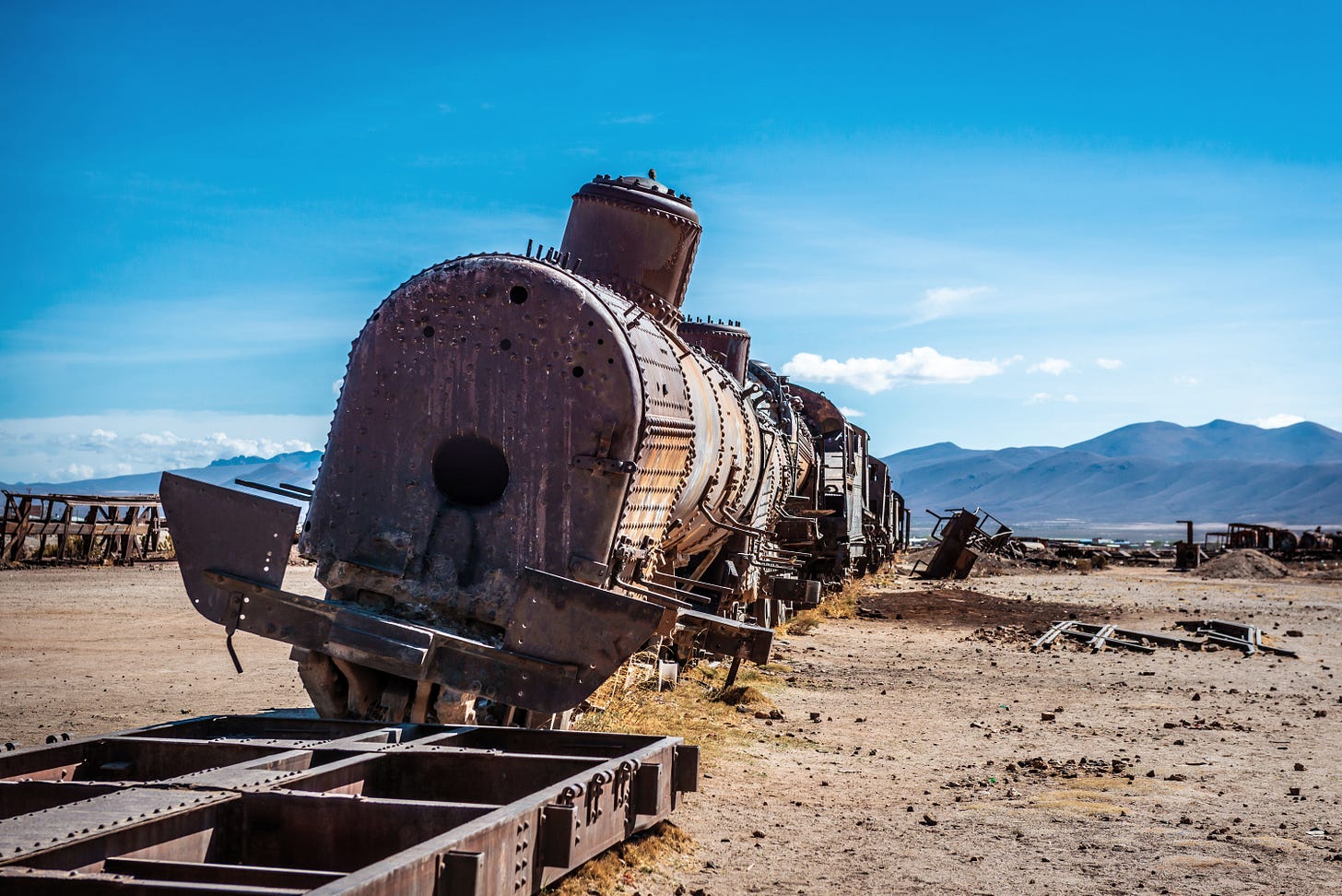White Swans and Slow-Motion Train Wrecks
The crisis is the system so cosmetic reform cannot solve it.
Good Afternoon - On this Inauguration Day full of rousing Trumpian rhetoric and the fanfare of common hopium what follows will be a whimper not a bang. The promises made are many but the deliverables will be few and far between as white swans and slow-motion train wrecks wipe away the old order.
It has been said that the answer to 99 of every 100 questions is money, and this time will not be different. The America Republic, the Democratic experiment, the Constitutional framework loosley stitched together in 1787, sharply ripped apart in 1860, and frayed with each passing decade of the 20th century is now torn completely apart in the 21st. This is not an opinion so much as a judgement rendered by market (and other) forces on a nation spiraling into default, a Latin word meaning to deceive.
The financial system itself is the source of the crisis, and its breakdown is already in process.
People continue to ask me what is the source of the next financial crisis, when will it happen, and how to prepare. These are reasonable questions, but they are missing the elephant in the room, namely that the financial system itself is the source of the crisis, and its breakdown is well underway. Certainly there are other sinister structures but finance is the center of gravity and the center will not hold. Recall the words of old Georgetown Professor Carol Quigley:
“The powers of financial capitalism had another far-reaching aim, nothing less than to create a world system of financial control in private hands able to dominate the political system of each country and the economy of the world as a whole. This system was to be controlled in a feudalistic fashion by the central banks of the world acting in concert, by secret agreements arrived at in frequent meetings and conferences. The apex of the systems was to be the Bank for International Settlements in Basel, Switzerland, a private bank owned and controlled by the worlds central banks which were themselves private corporations. Each central bank...sought to dominate its government by its ability to control Treasury loans, to manipulate foreign exchanges, to influence the level of economic activity in the country, and to influence co-operative politicians by subsequent economic rewards in the business world.”
Carroll Quigley - Tragedy and Hope: A History of the World in Our Time
That system so intricately described above by Quigley is at its end. The next financial crisis started where the last one left off in '08 when Western governments and central banks transferred private liabilities onto public ledgers. Nothing was fixed, not the housing market, not the toxic debt, not the corruption and mismanagement of the financial and political systems. That all but guaranteed that the system itself would become the catalyst for the next financial crisis.
However, time passed and stocks soared so all was forgotten and the banks, the economy, and the currency went back to normal. Of course, a return to normalcy never happened. Rather, what did happen is the process of financialization became all consuming, systemic.
The process of financialization became all consuming, systemic.
America became a financial system with an economy rather than an economy with a financial system. Real wealth in terms of productivity, CAPEX, Gen M and X income-growth, and a broad-based increase in living standards (adjusted for inflation) stagnated or fell, papered over by debt and government statistics (inflation, employment etc.), which merely concealed the real social pain.
Financialization has pushed everyone from Boomers to Gen Z into speculation because there is nothing else left. As a result, households have record exposure to the stock market, global liquidity is vastly over allocated to US stocks, and even DC dangerously depends on stock market returns for revenue (capital gains).
Financialization has pushed everyone from Boomers to Gen Z into speculation because there is nothing else left.
Such desperation for income, revenue, and yield has jolted markets upward, flowing overwhelmingly into just 10 companies, which make up 30%+ of the S&P. Prior levels of concentration preceded devastating Wall Street crashes like the dot.com bubble.
Meanwhile, despite mainstream claims that the US economy is strong and getting stronger, crises of systemic proportions are enveloping everything: bond yields are spiking as fiscal deficits explode, big banks are sitting on nearly $1T of unrealized losses (probably far more), CRE is collapsing as metros hollow out, industrial production is in secular decline, auto, student, and mortgage loans face refinancing apocalypse, insurance companies non-renew homeowners across the US (see Palisades), and trade deficits surge as BRICS+ divest from USD denominated assets.
Everything, in other words, is disintegrating, slowly, but its beginning to accelerate and spread. Yet, despite the depths of the systemic mess whose main casualties have been middle class Americans (and Europeans), people believe with religious conviction that Fed printing, DC administrators or perhaps President Donald Trump himself have things well under control. "Extend and pretend" can go on forever.
Unfortunately, as John Rubino points out, there are "no political or technological fixes" because the system itself is the problem, it is the white swan. Such a reality is becoming unignorable as the slow-motion train wreck derails further and policymaker interventions only worsen the issues.
A reset is the only way forward, and a painful one it will be.
The system is the catalyst and the problem is the solution because a reset is the only way forward, and a painful one it will be. When blacks swans become white you know the end-of-cycle is near. Regrettably or otherwise, the only way out is through.
Stay alert. Stay liquid.










Timing is the tricky part. Despite the fragility of the system, its resilience is notoriously underestimated. Granted—for all the wrong reasons. The US dollar is still the reserve currency, backed by a military power. It could persist longer than many expect. Great article, by the way.
You're not wrong about the financial system but you're not really getting to the heart of the problem and therefore not providing true understanding of the root causes and how to solve them, namely, the right of the monopolistic state to counterfeit money.
The financial system per se it not able to do anything without there being the Big Brother waiting in the wings to save them from all their bad decisions by injecting 'liquidity' into the system.
As George Gammon points out, it's actually the fractional reserve banking that does the majority of the quantitative expansion of the money supply, which redistributes the resources toward the borrowers and leads to the misallocation of resources in speculative investments.
If the liquidity created out of thin air went into actual productive capacity it might not be a problem, but it's precisely the nature of a market pumped up with liquidity and socialized risk that it goes into speculative bubbles like the real estate bubble, or the dot com bubble.
So you have stagflation: a rising stock market pumped through inflation, and a stagnant unproductive economy.
Once you see that, you will see that the US and China are in pretty much the same situation, but of course we have to rely on the CCP data that masks a collapsing real estate and banking sector, rising unemployment and a stagnant economy.
The root course in the end is the Keynesian mixed economy statism.